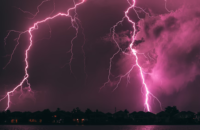Lightning During The Winters – A Definite Fire Hazard
 There have been numerous instances where homes and commercial properties have been struck and have had to go through the fire damage restoration process afterwards. Not only can lightning be frightening, but the risk of fire from the storm also increases considerably during the winter because of the dry atmospheric conditions.
There have been numerous instances where homes and commercial properties have been struck and have had to go through the fire damage restoration process afterwards. Not only can lightning be frightening, but the risk of fire from the storm also increases considerably during the winter because of the dry atmospheric conditions.
Damage from lightning is considered a natural disaster because of how it can lead to fire and a range of other types of structural damage. Unfortunately, the concept of lightning strikes at homes and commercial buildings isn’t unheard of – and is getting more common by the day.
Electricity always tries to find the path of least resistance. The higher a conductor is, the more chances of a lightning strike. This means that the antennae and satellite dishes on your rooftop, solar panel stations, or any other metallic object on the rooftop can also attract lightning strikes.
In this article, we will look at how lightning during the winters can lead to fire damage and what you can do to avoid it.
The Need For Fire Damage Restoration After Lightning
The National Fire Protection Association suggested that over 19% of house fires are because of lightning strikes. As storms keep getting worse, the prevalence of fire damage in homes is also increasing. The electrical surge caused in electrical systems often causes breakers to trip.
However, if there is a fault in the breaker system, the surge can result in an electrical discharge. If this discharge falls right onto insulation or other flammable material, it can result in fires that spread rather quickly.
It is important to note that the chances of this occurring are much higher in winters than in the summer. This is because of the overall dry weather conditions that the world faces.
How Lightning Can Lead to A Fire
Lightning can reach temperatures very high temperatures. Some records have shown lightning to reach 50000 F – that’s about 5x the temperature of the sun’s surface. While this surge in temperature lasts for less than a second, it is enough to burn everything in its path, even things that aren’t otherwise flammable.
You may have seen videos on the internet that show lightning split trees in half, turning roofs into rubble, or having otherwise devastating impacts. Even if there is no fire, lightning strikes’ aftermath looks similar to what you expect after a fire. This is why, after a strike, many recommend that you call the fire department or IICRC certified fire damage, restoration experts.
It is important to note, though, that lightning itself is not enough to compromise the structure of a building. Instead, it is the resulting fire that may trigger extensive damage. The aftermath may also result in water damage, especially if the strike was on the plumbing.
For example, if the lightning strike is directly on a pipe, it can not only burn and melt the pipe itself (if PVC or any other material) or superheat it (if metal), which boils the water inside and bursting joints.
How to Prevent The Risk of Fire Damage From Lightning
Earthing
One of the best ways to mitigate the risk of fire damage from lightning is to earth your electrical system and cover any metallic objects on your rooftop. While the latter may not always be practical, earthing your electrical systems may be enough to limit the extent of the damage.
When you ground your electrical system, you are basically giving the excess electricity and heat to be transferred from your system directly to the earth. While there will be a massive surge in temperature because of the lightning, regardless, the resulting fire will only be limited to the roof. That, too, won’t be an electrical fire, allowing you to extinguish it easily.
External Lightning Protection Systems
There are also several protection systems that you can go for that eliminate the risk of fire damage. These systems are designed to capture lightning before it hits any crucial part of your house. The system comprises an exposed earthing system that acts as bait for any lightning coming to your home.
Its coverage radius can be controlled by using different materials. Copper, for example, is more attractive for lightning compared to aluminum. These are also known as lightning rods.
Internal Lightning Protection Systems
Inside your house or building, you will need to protect against overvoltages. The goal is to protect crucial electrical system components against surges either via resistance or by breaking the circuit. These systems are known as coordinated surge protection systems.
Apart from protecting your system against electrical surges (and hence blows fuses), they also mitigate the risk of fire damage. With the right tools and prevention techniques, the risk of fire damage from direct and indirect damage can be mitigated extensively.
The risk of fire from lightning strikes isn’t just limited to houses but extends to airports, hospitals, industries, and even power stations. Commercial restoration requires more extensive procedures than residential fire damage restoration. To learn more about the risk of fire damage because of lightning during winters and the restoration process therein, give 911 Restoration of Fremont County a call today!


